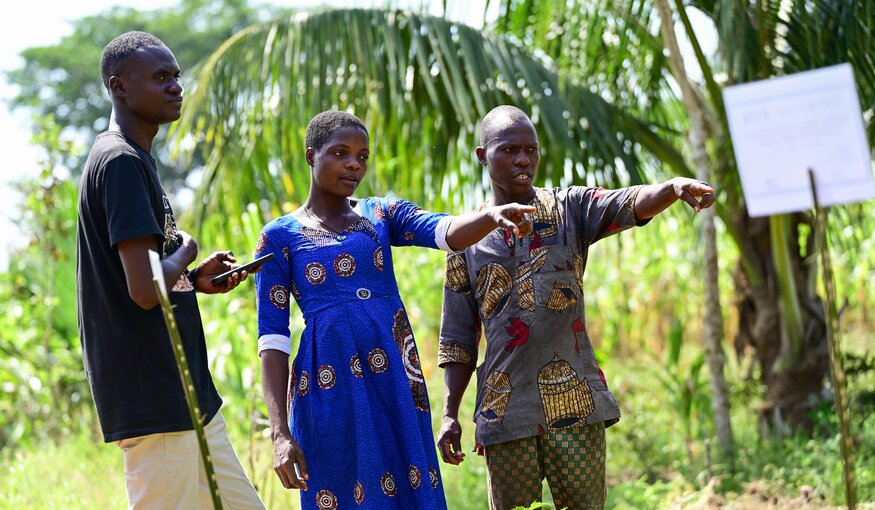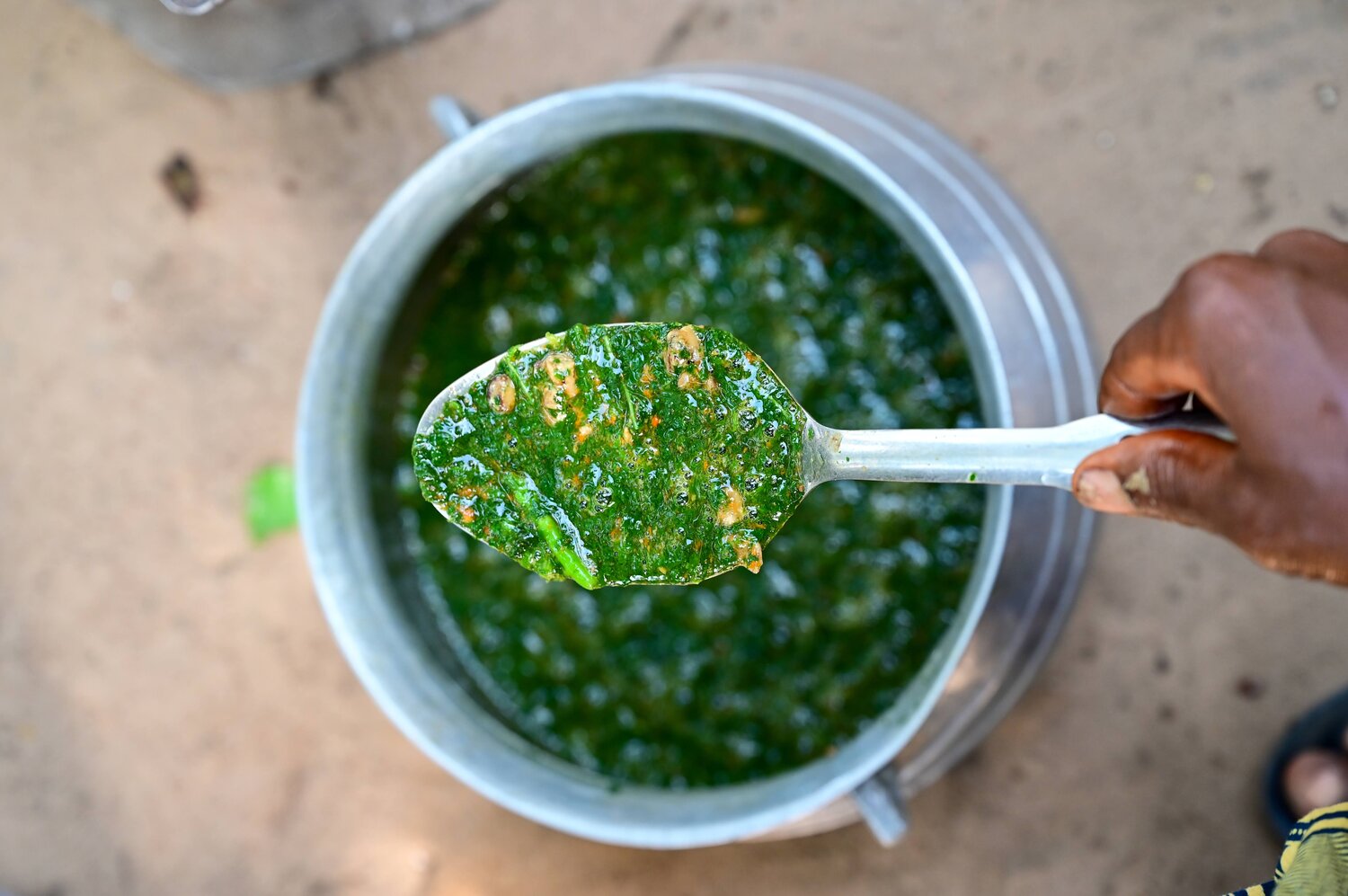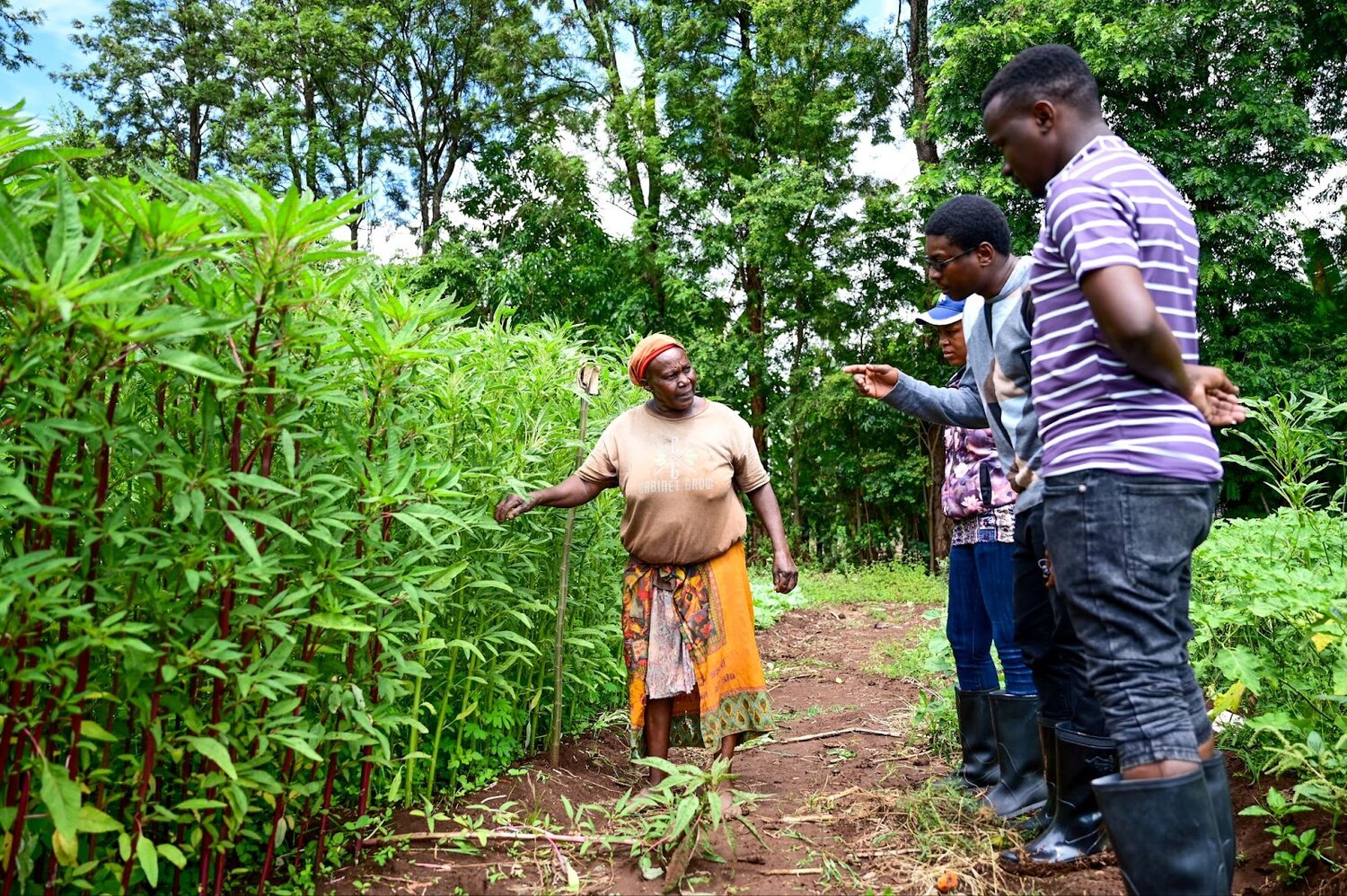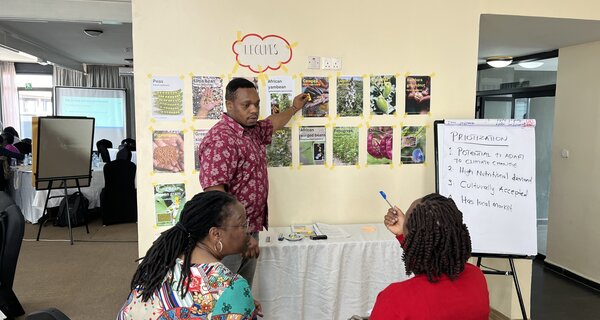BOLDER’s Citizen Science Approach Unlocks New Opportunities for Underutilized Crops in Benin and Tanzania

Farmers from Agbedranfo in Benin share feedback on their trials of jute mallow – a vegetable appreciated for its sliminess – to a field agent (left), who uses a dedicated app to collect the information. Photo: Neil Palmer/Crop Trust
30 June 2025
During the first few hours of daylight – before the sun gets high and it’s too hot outside – experimental fields at the World Vegetable Center (WorldVeg) research station in Cotonou, Benin, are buzzing with activity. Solar-powered irrigation systems pump water to stands of jute mallow, eggplant and chili pepper, while field workers patrol the plots.
These kinds of experiments are crucial to understanding how the crops perform. But they only tell part of the story. Conditions at research stations tend to be closely controlled, while in farmers’ fields, where in the end the crops will have to prove themselves, things can be more varied and challenging. Also, a crucial component is missing from the on-station trials – the farmers themselves. Their preferences are critical in determining whether a crop succeeds or fails in the real world.
To overcome these shortcomings of research station experiments, the Crop Trust’s BOLDER project uses a novel approach: triadic comparison of technologies, or tricot for short. That’s a complicated name for a simple concept that has nothing to do with highly stretchy fabric: engaging farmers as “citizen scientists” to conduct trials on their own farms, under local conditions, and report the results. The technologies in this case? Vegetable seeds.
In Benin and Tanzania, the vegetables undergoing tricot trials are jute mallow and amaranth. These are generally overlooked species that haven’t received the scientific attention given to staples like rice or maize. But they hold great promise as climate-resilient, nutritious, and profitable options for farmers in many parts of Africa. That’s why they are often referred to as opportunity crops.
Tricot trials help scientists test these crops with lots and lots of farmers under diverse, real-world conditions. In addition to giving farmers a first and close look at crop diversity that may be unfamiliar to them, the trials provide scientists with insights into plant performance and farmer preferences, which can then feed into breeding and other research efforts.
Bring on the Slime
In Benin, WorldVeg and the Genetics, Biotechnology and Seed Science (GBioS) unit at the University d’Abomey-Calavi are leading tricot trials for jute mallow. This crop is prized as a key ingredient in the staple dish crincrin – a thick, slimy, dark green soup containing seafood and chunks of beef skin, typically served with pounded yam or èba (fermented cassava flour).

A spoonful of sauce from the staple Beninese dish crincin, whose signature rich green colour and sliminess come from jute mallow leaves, and are much sought after by consumers. Photo: Neil Palmer/Crop Trust
Despite an estimated 300 million people in West Africa regularly consuming jute mallow, there is no formal crop breeding programme. Instead, farmers grow, select and share seeds with each other, with little outside help.
Following consultations with traders, seed producers and others in the jute mallow value chain in Benin, WorldVeg shortlisted six promising samples from its collection of 360 or so at its genebank in Arusha, Tanzania. The selection was based on known farmer preferences for traits like leaf mucilage (the technical term for sliminess) and nutritional characteristics such as the prevalence of iron and zinc.
Then, 180 farmers in three regions of Benin each received seed packets of three jute mallow samples marked A, B, and C. They germinated the seeds and transplanted them to marked plots. Field agents then logged the geographic location of the plots, socio-economic information on the farmers, and the farmers’ evaluations of the resulting crop using a special smartphone app that syncs to ClimMob, a dedicated tricot platform that aggregates data for researchers.
The app captured the observations of farmers like Leonie Kodo and Adolphe Noumon in Dogbo, in southwestern Benin. They really liked fast-growing jute mallow varieties that they expected to have that all-important sliminess when cooked, typically indicated by the shininess of the leaves. They didn’t like one variety because its leaves resembled those of a common weed, meaning it might be rejected in the market.
According to Enoch G. Achigan-Dako, head of GBioS, the response from farmers has been delightful, with word spreading rapidly in one area of a genebank variety with particularly high mucilage. “These trials have increased the quality and robustness of our data on jute mallow,” he said.
Amaranth in Tanzania
In Tanzania, WorldVeg worked with the Tanzania Agricultural Research Institute (TARI) to establish tricot trials for amaranth, produced for its edible seeds and leaves. These trials involved 184 farmers in the Arusha and Kilimanjaro regions, again with six samples shortlisted from the WorldVeg amaranth collection. Each farmer received three of these, chosen at random.
Some plots contained plants with long, slender leaves, others with larger, more rounded ones. Some plants had green petioles, others pink. Farmers typically made their preferences known based on market traits such as leaf size and colour. Some varieties were chosen solely for their seeds, which are commonly used to make a nutritious porridge.

A farmer from the Kilimanjaro Region of Tanzania explains the performance of one of her tricot plots of amaranth to researchers from WorldVeg and the Tanzania Agricultural Research Institute (TARI). Photo: Neil Palmer/Crop Trust
Sognigbé N’Danikou, genebank manager at WorldVeg in Tanzania, noted that through the amaranth tricots, farmers had discovered varieties that could be grown for both their leaves and grain. They also showed a strong preference for the Nguruma variety, with its resilience to drought and vigorous growth, which enables farmers to harvest leaves five or even six times in a season.
In addition, he said the trials provided farmers with the opportunity to identify varieties with leaves suitable for drying and storage, useful for household consumption during periods of food shortage.
Even small distances between farms had an impact on farmer preferences. Amaranth that performed well in one plot sometimes struggled in a nearby one – perhaps due to differences in drainage and prevalence of diseases like root rot, for example.
In one case, opinions differed even within the same household. In the Kikwe District of Arusha Region, farmer Edward Zephania Pallangyo preferred the taste of amaranth in plot B. His wife Mama Aliana, meanwhile, preferred that in plot A. Given that the trial was taking place in their kitchen garden, they will presumably need to agree on which ends up in the cooking pot. Maybe both will. No need for tricots to disturb household harmony.
To the Market
In both Benin and Tanzania, many farmers participating in the tricot trials welcomed the opportunity to sell what they had grown as part of the tricot trials. The next phase of the work of BOLDER will expand tricot trials to involve consumers and traders. The combined results will reveal a clearer picture of what makes a really great jute mallow and amaranth, which breeders can use as the basis for improving current varieties.
From that, everyone stands to gain.
Categories: For The Press, For Partners, BOLD, Food Security, Nutritional Security



